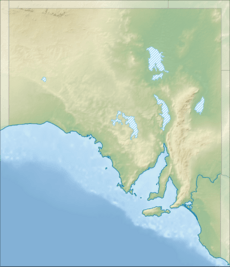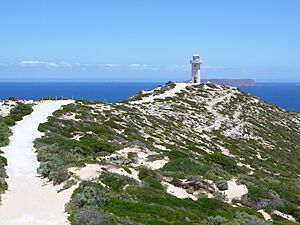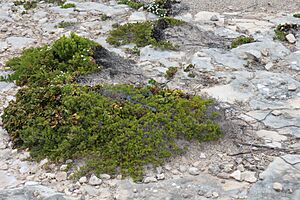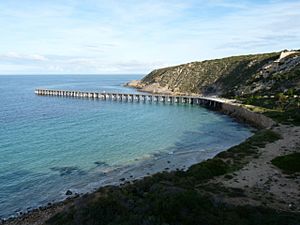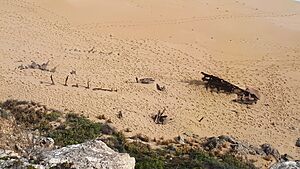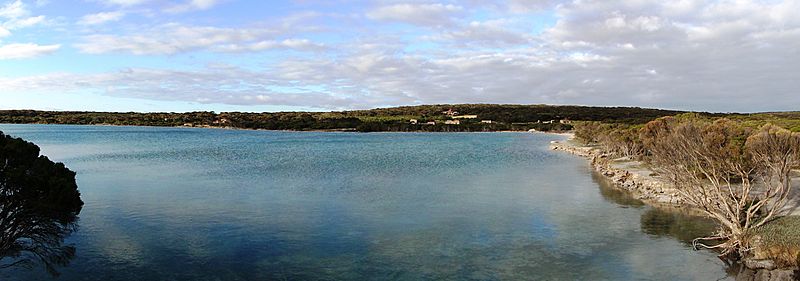Dhilba Guuranda–Innes National Park facts for kids
Quick facts for kids Dhilba Guuranda–Innes National ParkInneston, South Australia |
|
|---|---|
|
IUCN Category II (National Park)
|
|
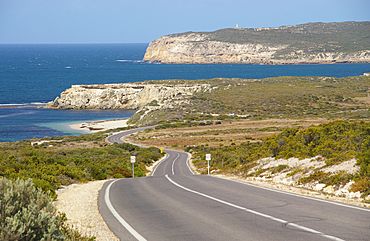
Looking west towards Cape Spencer
|
|
| Nearest town or city | Marion Bay |
| Established | 5 March 1970 |
| Area | 94.15 km2 (36.4 sq mi) |
| Visitation | 200,000 (in 2003) |
| Managing authorities | Department of Environment and Water |
| Website | Dhilba Guuranda–Innes National Park |
| See also | Protected areas of South Australia |
Dhilba Guuranda–Innes National Park is a special protected area in South Australia. It used to be called Innes National Park. You can find it on the southwest tip of the Yorke Peninsula, about 300 kilometers (186 miles) west of Adelaide. This park is a great spot for lots of outdoor fun like camping, bushwalking, fishing, surfing, and scuba diving. It's a place where nature is kept safe for everyone to enjoy.
Contents
Park History
Early Days of the Land
For thousands of years, the Narungga people lived on the Yorke Peninsula. They are the traditional owners of this land. They have strong cultural ties to the area. Some places in the park are very important to their spiritual beliefs.
Around 1846, Europeans started settling here. They used the land for sheep grazing. Later, in the early 1900s, a man named William Innes found a lot of gypsum. Gypsum is a mineral used in things like plaster. He started a mining town called Inneston in 1913. At its busiest, about 500 people lived there.
Mining stopped in 1930 because of the Great Depression. In 1970, the government bought the town and land. This is how Innes National Park was created. Some gypsum mining still happens nearby in Marion Bay.
Becoming a National Park
The park officially opened on March 5, 1970. It was named Innes National Park. The main reasons were to protect important homes for birds like the western whipbird and the mallee fowl. It also aimed to save old buildings in Inneston. More land was added to the park over the years. This helped with more people visiting and enjoying the park.
On November 14, 2020, the park got a new name: Dhilba Guuranda–Innes National Park. This new name honors an agreement between the South Australian government and the Narungga people. It shows their shared care for the land. Some of the old buildings in Inneston have been fixed up. You can even stay in them!
What the Park Looks Like
Where is the Park?
Dhilba Guuranda–Innes National Park is at the very end of the Yorke Peninsula. It's about 300 kilometers (186 miles) by road from Adelaide. The park is located within the area known as Inneston.
Park Boundaries
The park covers most of the land on the southwest tip of the peninsula. It also includes four small islands close to the coast. These islands are Chinamans Hat Island, Middle Island, South Island, and Royston Island.
Some areas within the park are not open to visitors. These "no access" areas help protect sensitive wildlife and habitats. They include parts of the coastline and some of the islands.
Coastal Features
The coastline of the park is very interesting. You'll find many bays like Cable Bay and Stenhouse Bay. There are also tall cliffs, some as high as 79 meters (259 feet). Sandy beaches are found at the bottom of these cliffs. Other parts of the coast have large sand dunes. Inside the park, you can also see several salty lakes.
Getting Around the Park
The park has a main road that connects to the Yorke Highway. This road starts at Stenhouse Bay. It follows the coastline, passing by many beautiful spots. You can drive to places like Cape Spencer, Ethel Beach, and Pondalowie Bay. Some parts of the road are sealed, while others are unsealed.
Protecting Nature
This national park is a special type of protected area. It's called an IUCN Category II protected area. This means it's a large natural area protected for its ecosystems and for recreation.
The ocean waters next to the park are also protected. They are part of the Southern Spencer Gulf Marine Park. This helps keep the marine life safe.
The park is also part of an Important Bird Area. This is because it's home to important birds like the mallee fowl and the western whipbird. These birds need special protection.
Plants and Animals
Park Plants
In 2003, experts found 333 different kinds of native plants in the park. Many of these plants are very important for conservation. Some are even listed as protected species under Australian laws. These include plants like annual candles and winter spider-orchids.
Park Animals
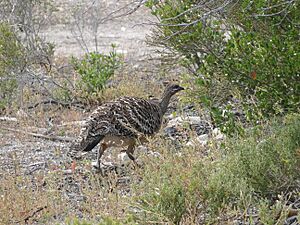
The park is home to many amazing animals:
- Mammals: You might see western grey kangaroos, short-beaked echidnas, and New Zealand fur seals. You could even spot common dolphins or southern right whales in the waters nearby.
- Birds: Over 100 types of native birds live here. Important ones include the malleefowl, western whipbird, osprey, and white-bellied sea-eagle.
- Reptiles: Many reptiles call the park home. These include the marbled gecko, painted dragon, yellow-faced whipsnake, and the sleepy lizard.
Bringing Animals Back (Marna Banggara Project)
There's an exciting project called Marna Banggara happening here. It aims to bring back animals that used to live in the area but disappeared. To do this, they removed pests like foxes and cats. They also built a special fence across the Yorke Peninsula.
In 2021, the first animals were brought back: brush-tailed bettongs, also known as woylies. These small marsupials were moved from an island to the park. More woylies were brought from Western Australia in 2022. This helps make sure the woylie population in the park stays healthy. The goal is to bring back about 20 different animal species by 2040!
Special Heritage
The park is important for its natural beauty and its history.
Natural Wonders
Three special salt lakes in the park are listed on the South Australian Heritage Register. These are Deep Lake, Inneston Lake, and Marion Lake. They are unique because they have stromatolites. Stromatolites are ancient rock-like structures made by tiny living things.
Aboriginal Heritage
More than 20 important sites for the Narungga people have been found in the park. These include burial sites and other archaeological places. They show the long history and deep connection the Narungga people have with this land.
European History
Mining History
Two places linked to gypsum mining are also on the heritage list. These are the "Inneston Gypsum Complex" and the Stenhouse Bay Jetty. They remind us of the park's mining past.
Shipwrecks
Several old shipwrecks are found near the park's coast. They are protected by law because they are part of history.
- The SS Marion ran aground in 1862.
- The Ethel shipwreck happened in 1904 at a beach now called Ethel Beach. The ship's remains are still there, sometimes covered by sand.
- The SS Ferret also ran aground at Ethel Beach in 1920.
- The Hougomont was sunk on purpose in 1932 near Stenhouse Bay. It was used to create a breakwater, which helps protect the harbor from waves.
Things to Do and See
Camping
You can camp at several spots in the park. These include Stenhouse Bay, Cable Bay, and Pondalowie Bay. There are also camping grounds at Shell Beach, Browns Beach, and Gym Beach.
Places to Stay Indoors
If you prefer not to camp, you can stay in restored buildings at Inneston. There's also the Stenhouse Bay hall and a cottage at Shell Beach available for hire.
Walking Trails
The park has many walking trails. These trails offer amazing views of the coast and ocean. You can also spot plants and animals, and see lighthouses and historic sites. Some popular trails are the Thomson Pfitzner Plaster Trail Hike, the Royston Head Hike, and the Gym Beach Hike. There are also shorter trails to places like Cape Spencer and Ethel Beach.
Surfing
The main surf spot at Pondalowie Bay is very popular. It has both left and right waves that break over a reef and sand. The right wave can be quite big and good for experienced surfers. Another smaller wave called "Richard's Reef" is nearby. Closer to Stenhouse Bay is "Chinaman's," a powerful wave only for skilled surfers.
Gallery
See also
 In Spanish: Parque nacional Innes para niños
In Spanish: Parque nacional Innes para niños
- Protected areas of South Australia
- Cape Spencer Lighthouse (South Australia)


